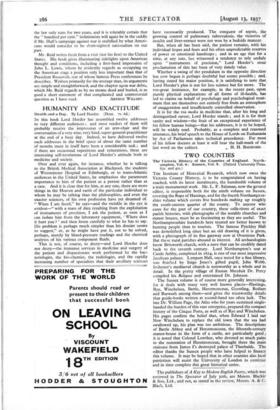TWO COUNTIES
THE Institute of Historical Research, which now owns the Victoria County History, is to be congratulated on having reached, with its latest instalments, the hundredth volume of a truly monumental work. Mr L F Salzman, now the general editor, is responsible both for the ninth volume on Sussex, covering the Rape of Hastings, and for the fourth Northampton- shire volume which covers five hundreds making up roughly the south-eastern quarter of the county. To anyone who cares for the past of our country, these collections of exact parish histories, with photographs of the notable churches and manor houses, must be as fascinating as they are useful. The Northamptonshire hundreds here treated are better known to hunting people than to tourists. The famous Pytchley Hall was demolished long since but an old drawing of it is given, with a photograph of its fine gateway now at Overstone Park. But these rural parishes abound in interest. All archaeologists know Brixworth church, with a nave that can be credibly dated back to the seventh century. Lord Northampton's seat at Castle Ashby, completed in 1624, is one of our most impressive Jacobean palaces. Lamport Hall, once noted for a fine library, was finished by Inigo Jones's gifted pupil, John Webb. Irchester's mediaeval church is noteworthy as a whole and in detail. In the pretty village of Easton Mauduit Dr. Percy compiled his Reliques and entertained Dr. Johnson.
The Sussex volume is of course more generally interesting, for it deals with many very well known places—Hastings, Rye, Winchelsea, Battle, Herstmonceux, Guestling, Bodiam and Burwash among them—and gives the trustworthy details that guide-books written at second-hand too often lack. The late Dr. William Page, the Atlas who for years sustained single- handed the burden of this vast enterprise, prepared the compact history of the Cinque Ports, as well as of Rye and Winchelsea. His pages confirm the belief that, when Edward I laid out New Winchelsea to replace the old town that the sea had swallowed up, his plan was too ambitious. The descriptions of Battle Abbey and of Herstmonceux, the fifteenth-century manor-house in the form of a castle, are particularly good ; it is noted that Colonel Lowther, who devoted so much pains to the restoration of Herstmonceux, brought there the main staircase from James I's destroyed palace of Theobalds. The editor thanks the Sussex people who have helped to finance this volume. It may be hoped that in other counties also local patriotism will assist the University of London to continue and in time complete this great historical series.






































 Previous page
Previous page